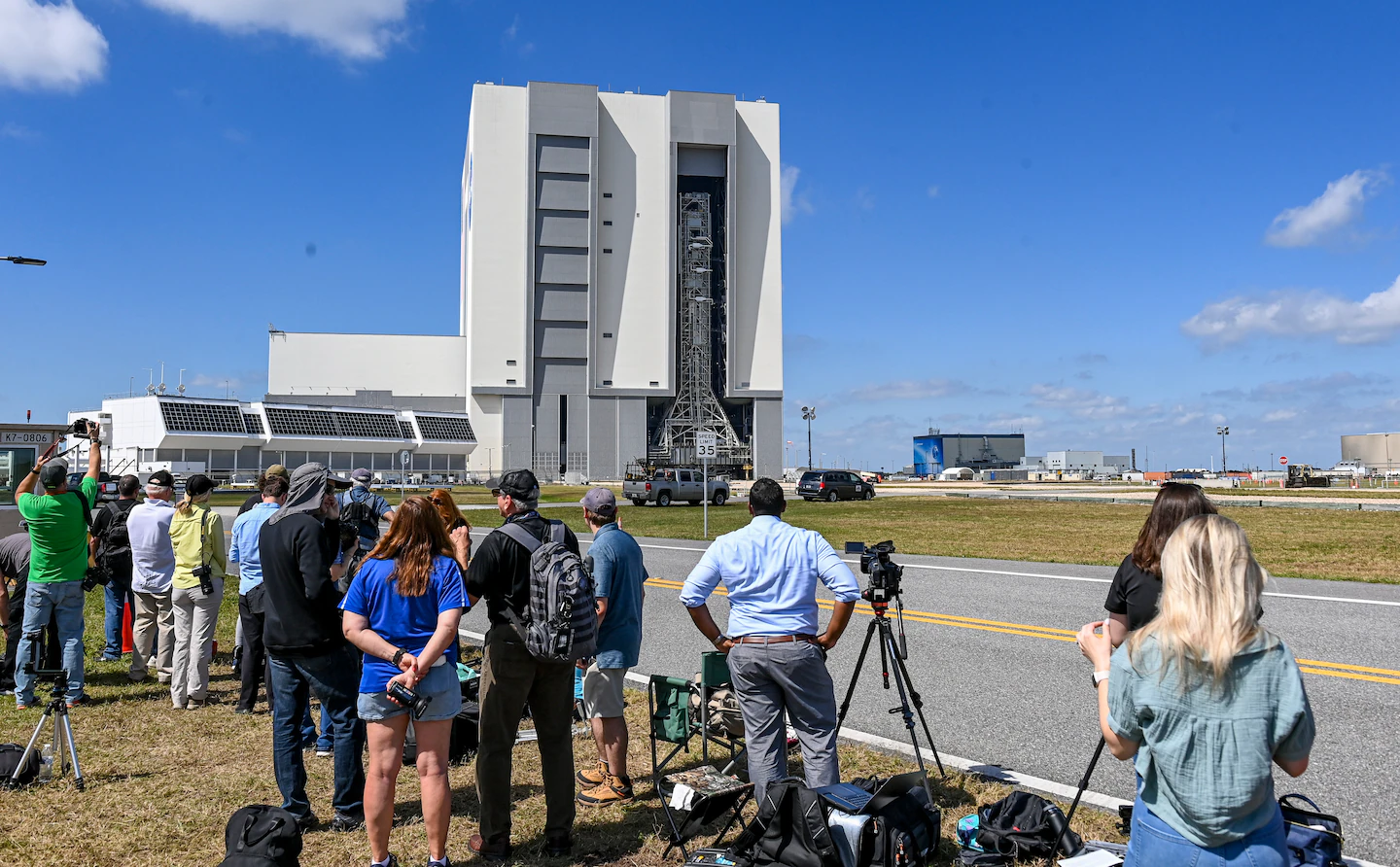
Space Launch System
Block 1 rocket
Total height:
322 feet
Mobile launcher/
umbilical tower
Total height:
364 feet
Launch-abort
escape rocket
Orion
spacecraft,
service
module
Interim
cryogenic
propulsion
upper
stage
Brackets,
umbilicals to brace and fuel
the rocket
WILLIAM NEFF/THE WASHINGTON POST

Space Launch System
Block 1 rocket
Total height:
322 feet
Mobile launcher/
umbilical tower
Total height:
364 feet
Launch-abort
escape rocket
Orion
spacecraft,
service module
Interim cryogenic
propulsion upper
stage
Brackets and umbilicals to brace and fuel the rocket
WILLIAM NEFF/THE WASHINGTON POST

Mobile
launcher
Total height:
364 feet
Space Launch System
Block 1 rocket
Total height:
322 feet
Launch-abort
escape rocket
Orion spacecraft,
service module
Brackets and umbilicals to brace and fuel the rocket
Interim
cryogenic
propulsion
upper
stage
WILLIAM NEFF/THE WASHINGTON POST

On Thursday afternoon, NASA started rolling the fully configured rocket out of what’s known as the Vehicle Assembly Building (VAB) at Kennedy Space Center in Florida in a debut that would allow the public to see the monster Space Launch System (SLS) rocket for the first time. While the rollout marks a glimmer of good news, the program continues to face intense criticism over costs and its aging technology.
Last week, NASA’s inspector general, Paul Martin, told Congress that his office had calculated the cost for the first three flights of the SLS to be $4.1 billion each, a price tag he said was “unsustainable.”
In an era when SpaceX and other companies are building rockets that can be reused for multiple flights, Martin said, “relying on such an expensive, single-use rocket system will, in our judgment, inhibit if not derail NASA’s ability to sustain its long-term human exploration goals to the moon and Mars.”
NASA has pushed back against that criticism, saying the system has made real progress and that the costs will come down over time. The coming-out ceremony was a sign of that, agency officials said, and a giant leap for NASA’s Artemis program, a series of flights that NASA hopes will eventually return astronauts to the lunar surface for the first time since 1972.
Thousands were on hand to cheer as the rocket began its journey to the launch site, applauding as it emerged into the Florida sun at 5:47 p.m.
“It’s going to be just a wonderful, wonderful sight when we see that amazing Artemis vehicle crossing the threshold of the VAB and see it outside of that building for the very first time,” Charlie Blackwell-Thompson, the Artemis launch director, told reporters this week. “I think it’s going to really be breathtaking.”

A big rocket, and bigger to come
Saturn V
moon
rocket
(1967-73)
SpaceX
Starship
(planned)
WILLIAM NEFF/THE WASHINGTON POST

A big rocket, and bigger to come
Saturn V
moon rocket
(1967-73)
SpaceX
Starship
(planned)
WILLIAM NEFF/THE WASHINGTON POST

A big rocket, and bigger to come
Saturn V moon rocket
(1967-73)
SpaceX Starship
(planned)
WILLIAM NEFF/THE WASHINGTON POST

The SLS’s first launch is expected to occur sometime this spring. But first NASA needs to run a series of tests, starting by rolling the rocket with the Orion crew capsule perched on top to the launchpad, a journey that begins Thursday. To get there, it will stand vertically atop NASA’s crawler-transporter, a massive vehicle with tank-like treads that dates to the Apollo era. It will creep — very slowly, very carefully — to pad 39B some four miles away, cruising at 0.8 miles per hour over about 11 hours. There, over the days and weeks to come, NASA will connect the rocket to the ground systems and eventually fully fuel it. Then NASA will simulate a countdown in what’s known as a “wet dress rehearsal.”
If all goes well, the SLS then will be rolled back to the assembly building, where NASA will run more tests to make sure everything is operating correctly before attempting a launch.
That first flight, Artemis I, which could come as early as May or June, is intended to send the Orion capsule, without any astronauts aboard, into orbit around the moon before coming home and splashing down in the ocean.
NASA hopes to do another test flight that would send astronauts into lunar orbit sometime in 2024, and follow that by having astronauts land on the moon by 2025.
But those timelines are likely to change given the complexities of the program and the multiple problems it has suffered over the years.
Speaking to the crowd at Kennedy Space Center on Thursday, NASA Administrator Bill Nelson reiterated NASA’s pledge to send a more diverse crew to the moon than it did during the Apollo era.
“This generation will return astronauts to the moon, and this time we will land the first woman and the first person of color on the surface to conduct groundbreaking science,” he said. “There’s no doubt that we are in a golden era of human space exploration, discovery and ingenuity in space.”
Born in the ashes of a program called Constellation, which was canceled for excessive cost overruns, the SLS and Orion program started in 2010 as NASA’s next attempt to return astronauts to deep space. But over the years it also suffered all sorts of delays and cost overruns that have filled numerous reports from the Government Accountability Office and the NASA inspector general.
At a House Science Committee hearing this month, Martin, the NASA inspector general, criticized a program sometimes derided as the Senate Launch System because of the jobs it creates in key congressional districts and the fact that the program is headquartered in Alabama, home to Sen. Richard C. Shelby (R), the powerful chairman of the Appropriations Committee.
During the hearing, Martin took aim at the agency, saying NASA needed to be better about “controlling the program’s enormous expense and technical risks.”
Using data from a report the inspector general’s office produced late last year, he said he estimated that NASA will spend $53 billion on Artemis between 2021 and 2025. He said his $4.1 billion estimate of the cost for each of the SLS’s first three launches included “only production costs for SLS, Orion and ground operations and does not include the billions of development costs required to get the Artemis program to this point in time.”
Aside from the immense cost of the SLS, he said the many technical challenges with the spacecraft SpaceX is developing to land astronauts on the moon — a separate program from the SLS and Orion — plus the cost of the space suits they will need once there means the first crewed landing “likely will slip to 2026 at the earliest.”
NASA and industry officials have pushed back against those numbers, saying they incorporate all sorts of costs not directly related to the development of the system. After the first three launches, once the program reaches a regular cadence, the per-launch price would come down dramatically, they said. And it was a fraction of the price of the Apollo program and the Saturn V rocket used to get astronauts to the moon.
John Honeycutt, NASA’s SLS program manager, told reporters in Alabama that “the SLS rocket is not going to come at a cost of $4 billion a shot,” according to AL.com.
In a statement after Martin’s testimony, Boeing, the prime contractor on the rocket’s core stage, said that “when adjusted for inflation, NASA has developed SLS for a quarter of the cost of the Saturn V and half the cost of the space shuttle.” It added that the main elements of the Artemis program “have been developed for a fraction of the cost of the comparable Apollo program systems and will continue to become more affordable as the programs transition from development to operations.”
NASA has maintained that 2025 is achievable and said Thursday’s rolling-out was a key milestone that showcases just how far the rocket has come.
The emergence from the VAB is “an iconic moment for this vehicle,” Tom Whitmeyer, NASA’s associate administrator for exploration systems development, said during the briefing this week. “And to be here for a new generation of a super heavy-lift, exploration-class vehicle is going to be a day to remember. We’re really excited about that.”
Source link





